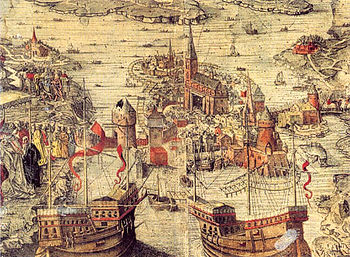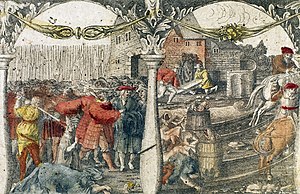Stockholm Bloodbath

The Stockholm Bloodbath (Swedish: Stockholms blodbad; Danish: Det Stockholmske Blodbad) was a trial that led to a series of executions in Stockholm between 7 and 9 November 1520. The event is also known as the Stockholm massacre.[1]
The events occurred after the coronation of
Background
Political factions in Sweden
The Stockholm Bloodbath was a consequence of conflict between Swedish pro-unionists (in favour of the
Military interventions of King Christian
King Christian, who had already taken measures to isolate Sweden politically, intervened to help Archbishop Trolle, who was under
Sture was mortally wounded at the
In May, the Danish fleet, led by King Christian, arrived and Stockholm was attacked by land and sea. Lady Kristina resisted for four months longer, and in the beginning of autumn Kristina's forces began winning. The inhabitants of Stockholm had a large supply of food and fared relatively well. Christian realized that his stockpile was dwindling and that it would doom his army to maintain the siege throughout the winter. With the help of
Massacre

On 4 November, Christian was
On the evening of 7 November, Christian summoned many Swedish leaders to a private conference at the palace. At dusk on 8 November, Danish soldiers, with lanterns and torches, entered a great hall of the royal palace and imprisoned several noble guests. Later in the evening, even more of the king's guests were imprisoned. All these people had previously been marked down on Archbishop Trolle's proscription list.[5]
The following day, 9 November, a council, headed by Archbishop Trolle, sentenced the proscribed to
The executions continued throughout the following day (10 November).[5] According to the chief executioner, Jörgen Homuth, 82 people were executed.[9] It has been claimed that Christian also took revenge on Sten Sture's body, having it dug up and burnt, as well as the body of his child.[5] Sture's widow Lady Kristina and many other noblewomen were taken as prisoners to Denmark.[10]
Aftermath
Christian justified the massacre in a proclamation to the Swedish people as a measure necessary to avoid a papal
Gustav Vasa was a son of Erik Johansson, one of the victims of the executions. Vasa, upon hearing of the massacre, travelled north to the province of Dalarna to seek support for a new revolt. The population, informed of what had happened, rallied to his side. They were ultimately able to defeat Christian's forces in the Swedish War of Liberation. The massacre became the catalyst that permanently separated Sweden from Denmark.[12]
Later reception and propaganda
The Stockholm Bloodbath precipitated a lengthy hostility towards Danes in Sweden, and from then on the two nations were almost continuously hostile toward each other. These hostilities, developing into a struggle for hegemony in the Scandinavian and North German area, lasted for nearly three hundred years. Memory of the Bloodbath served to let Swedes depict themselves (and often, actually regard themselves) as the wronged and aggrieved party, even when they were the ones who eventually took the political and military lead, such as the conquest and annexation of Scania until the Treaty of Roskilde in 1658.[13]
Christian the Tyrant and spurious "Christian the Good"
The event earned Christian II the nickname of Kristian Tyrann (Christian [the] Tyrant) in Sweden, which is retained in the present day.[14] It is a common misconception in Sweden that King Christian II is given the contrary byname Christian den Gode (Christian the Good) in Denmark, but this is apocryphal.[15]
According to Danish historians, no bynames have been given to Christian II in Danish historical tradition. In an interview with Richardson in 1979, Danish historian
In fiction
The event is depicted in the 1901 novel,
See also
- Kalmar Union
- Sten Sture the Younger
- Swedish War of Liberation
- Sture Murders
- Åbo Bloodbath
- Linköping Bloodbath
References
- ^ Usually called "Stockholm bloodbath" (natively Stockholms blodbad), the event is also known as "Stockholm massacre" in English, so called in the English translation of Erik Gustaf Geijer's Svenska folkets historia (1832–36), published in 1845 as The History of the Swedes (p. 102).
- ^ Lindqvist 1993, p. 13
- ^ Stockholm Bloodbath on Nationalencyklopedin's website. Retrieved 8 January 2014.
- ISBN 978-87-02-05665-5. Retrieved 6 July 2013.
- ^ a b c d e f g h One or more of the preceding sentences incorporates text from a publication now in the public domain: Bain, Robert Nisbet (1911). "Christian II.". In Chisholm, Hugh (ed.). Encyclopædia Britannica. Vol. 6 (11th ed.). Cambridge University Press. pp. 274–276.
- ISBN 91-85618-71-3
- ]
- ISBN 91-0-042947-3
- ISBN 9151843803p. 141
- Encyclopædia Britannica, Eleventh Edition, 1911, Christian II profile, gutenberg.org; accessed 12 May 2015.
- ISBN 9968-04-746-5
- ^ Hofverberg, Elin (9 November 2021). "The Stockholm Bloodbath of November 1520". Library of Congress - Blog. Library of Congress. Archived from the original on 20 January 2022. Retrieved 30 March 2024.
- ISBN 978-0-582-06429-4
- ISBN 978-91-85057-63-4. Retrieved 6 July 2013.
- ISBN 978-87-595-2373-5. Retrieved 6 July 2013.
- ^ Gunnar Richardson, "Kristian II – Tyrann eller den gode?", Dagens Forskning, 13 May 2002. [dead link]
- ISBN 978-87-02-04184-2. Retrieved 6 July 2013.
- ^ The New York Times Book Review. Arno Press. 1950. p. 9. Retrieved 6 July 2013.
- ^ Book Review Digest. H.W. Wilson Co. 1980. p. 435. Retrieved 6 July 2013.
- ^ Håfström, Mikael (2024-01-18), Stockholm Bloodbath (Action, History, War), Sophie Cookson, Alba August, Emily Beecham, Nordisk Film, Viaplay Studios, retrieved 2024-01-22
Sources
- Wolke, Lars Ericson (2006) Stockholms blodbad (Stockholm: Prisma) ISBN 91-518-4380-3
- Larsson, Lars-Olof (2003) Kalmarunionens tid, Bokförlaget Prisma (Stockholm: Andra upplagan) ISBN 91-518-4217-3.
- ISBN 9968-04-746-5.
- ISBN 91-47-05115-9.
- ISBN 91-85057-37-1.
